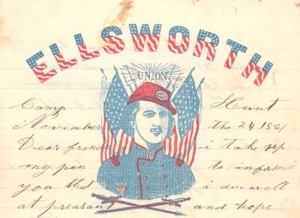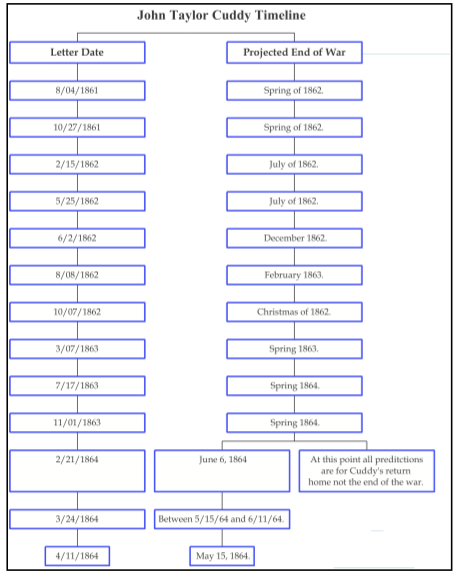John T. Cuddy’s letters give important insight into camp life and the thoughts and values of a sixteen-year-old Union soldier. Cuddy’s early letters are notable for his boyish exuberance about enlisting in the army. As he wrote on October 27, 1861, army life was akin to an adventure, “we have more fun here in one day than we had at home in one month.” Other areas of interest for Cuddy included receiving new uniforms, the arrival of new troops, and the sheer number of men to be found in and around an army camp. For instance, Cuddy wrote that 75,000 men were present at a review of troops at Camp Hunt and these men were “the bigust body of men that ever was saw in the united sats before.”
One of the most compelling aspects of Cuddy’s letters are his predictions about when the war will be over and he will be able to go home. The majority of Cuddy’s letters state his desire to “get home to spend a few happy monthes with you all [his family].” At first, Cuddy is extremely optimistic about the Union’s chances to quickly and decisively end the war. On August 4, 1861, he wrote that the war would end by the Spring because:

"the South will not last long for we will lick them once and they will give and the ware will be over." Image Courtesy of the In Their Own Words Collection.
However, the war did not end. As time passed his predictions slowly moved father and farther back. The following chart shows the dates of Cuddy’s letters and his prediction of when the war would end on each date.
Cuddy’s enthusiasm for the army did not last. About nine months into his service, Cuddy began to grow weary of the war and wished to return home. He first mentioned his homesickness in an April 30, 1862 letter; “i am tiard of it i have sean a nuf of vergineya now i have soldgering a leven monthes now i would like to be with you all tonite.”
Cuddy’s dissatisfaction continued to grow and he decided against re-enlisting in the Veteran Corps after his term of service ended. As he wrote in an August 25, 1863 letter, he would “never soldier eny more…for a soldier that soldier that dos his duty dos not gent eny more honour then one that dos not.”
John Cuddy never made it home, dying in a South Carolina prison camp in 1864.



Great work with this timeline. Nice visualization of data. You should make this post public.
Theres a paper written about this guy. Maybe you know this already, but it was written by Michele Tourney, who studied here. like I said if you’ve been through the archives you probably know about this already.
http://chronicles.dickinson.edu/libertycap/S02/tourney.html
I hadn’t seen this yet, thanks.